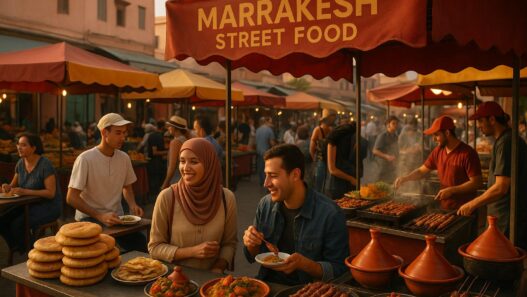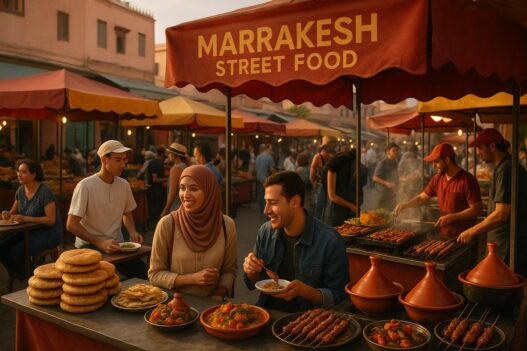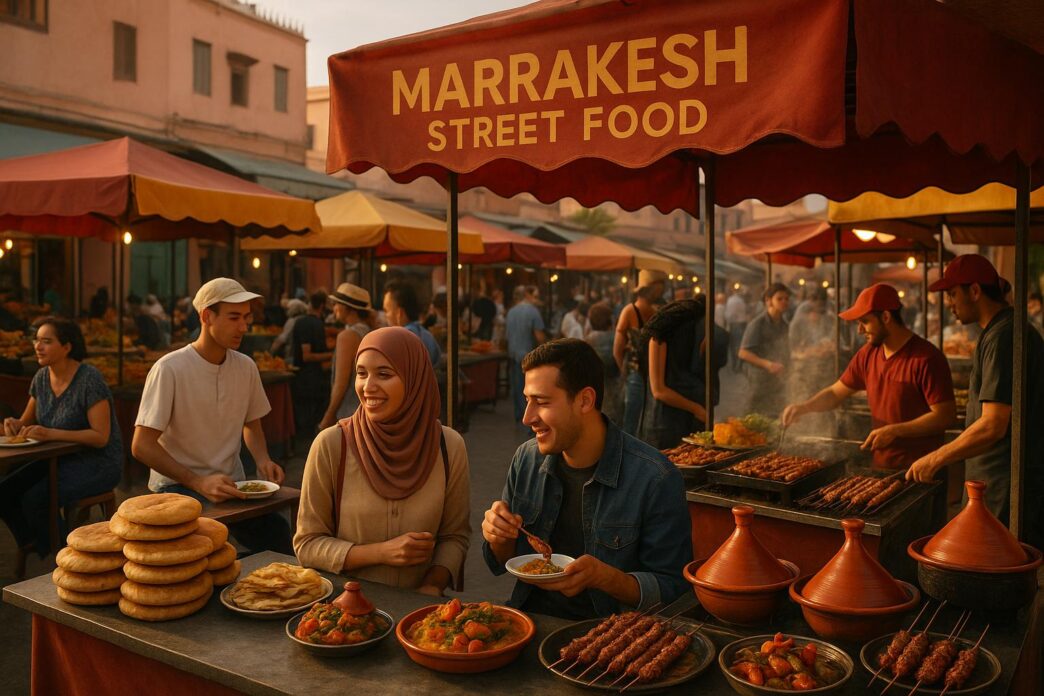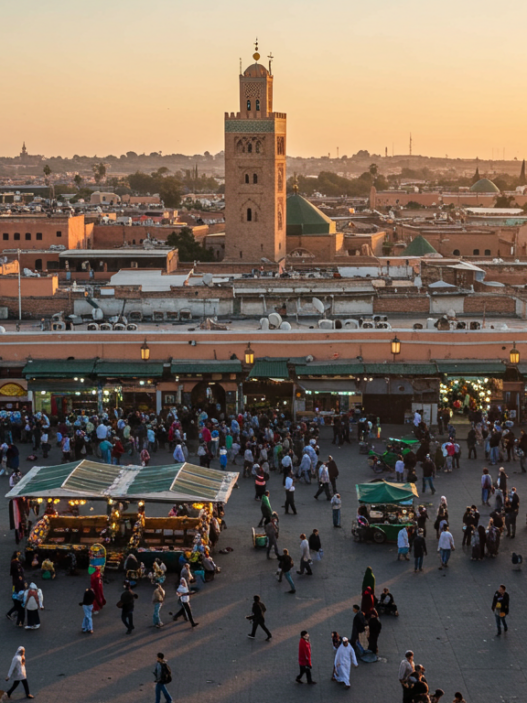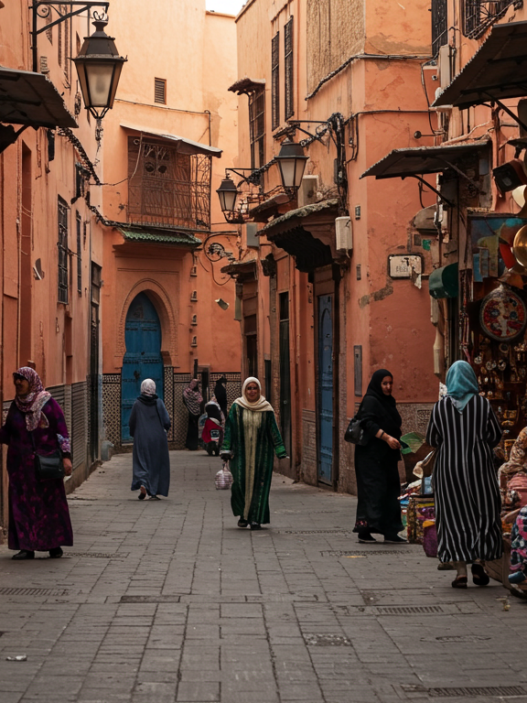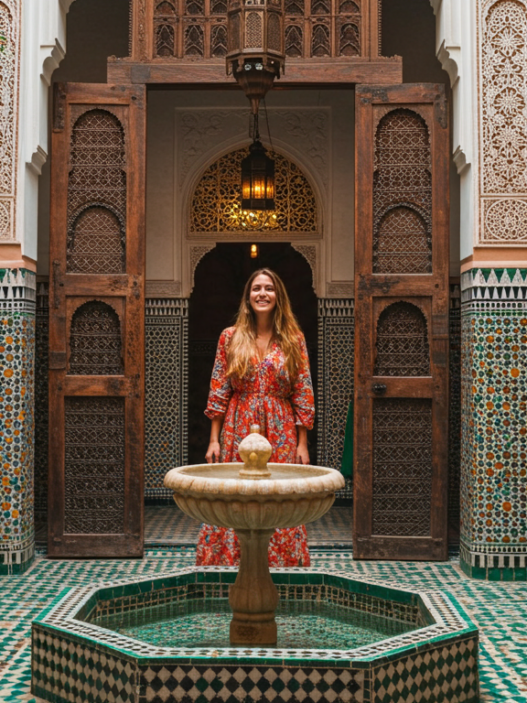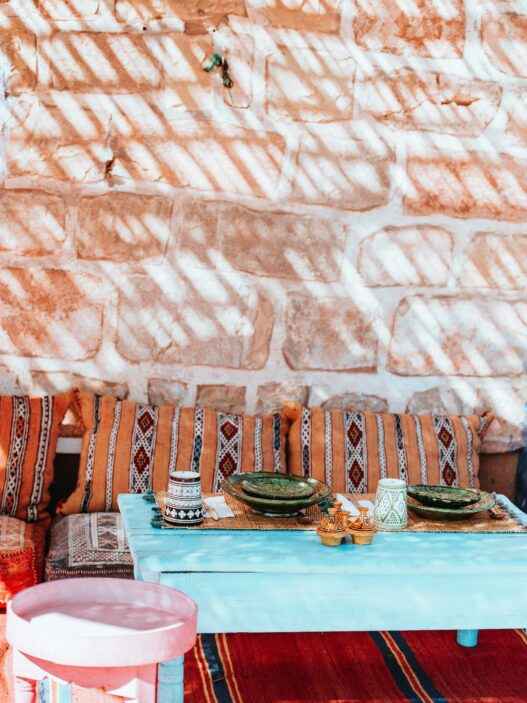Exploring Marrakesh in 2025? Here’s what you need to know about its vibrant street food scene:
- Affordable Eats: Most dishes cost between $1–4, offering generous portions and bold flavors.
- Improved Hygiene: Vendors now follow stricter cleanliness standards, with many displaying certifications.
- Digital Payments: While cash is still common, mobile payments and credit cards are increasingly accepted.
- Dietary Options: Vegetarian and vegan dishes are easier to find, with clear labeling and English-speaking vendors.
- Beyond Jemaa el-Fnaa: Neighborhood markets now offer quieter, more intimate food experiences.
Whether you’re sipping harira with dates, enjoying msemen pancakes, or exploring the bustling Jemaa el-Fnaa night market, Marrakesh offers an unforgettable culinary adventure. Follow locals, try guided tours, and savor the experience with every bite.
ULTIMATE Street Food Tour in MARRAKECH, MOROCCO!
Top Street Foods to Try in Marrakesh
If you’re wandering through the vibrant streets of Marrakesh, don’t miss these iconic street food experiences that showcase the city’s rich culinary heritage.
Harira with Dates and Chebakia
Harira is more than just soup – it’s a comforting dish deeply woven into Moroccan culture. This tomato-based soup, brimming with lentils, chickpeas, and tender meat, is especially cherished during Ramadan, when it’s traditionally paired with dates and chebakia to break the fast. Each spoonful of Harira feels like a warm embrace, offering a blend of hearty flavors that satisfy both the stomach and the soul.
Chebakia, on the other hand, is a delightful contrast to the savory soup. These fried pastries are soaked in honey and infused with an aromatic mix of cinnamon, fennel, turmeric, anise, and saffron. A touch of orange blossom water and white vinegar adds a subtle tang, making them irresistibly flavorful. Together, Harira and chebakia are not just a meal – they’re a celebration of Morocco’s communal dining traditions, and they’re easy on the wallet, making them a must-try for any visitor.
And if you’re in the mood for something lighter, Moroccan pancakes are another street food gem you can’t skip.
Moroccan Pancakes (Baghrir)
Baghrir, often called "thousand-hole pancakes", is a street food favorite known for its spongy, porous texture. Made from a simple batter of semolina, flour, yeast, baking powder, salt, and sugar, these pancakes are cooked on one side until their signature tiny holes form. The magic happens when they’re drizzled with warm honey and melted butter, creating a sweet, buttery treat that’s both delicate and satisfying.
Whether you’re enjoying them as a quick snack or a light breakfast, Baghrir captures the ingenuity and charm of Marrakesh’s street food scene. Plus, their affordability makes them perfect for travelers looking to savor authentic flavors without breaking the bank.
Best Street Food Stalls and Locations
Marrakesh’s street food scene is a feast for the senses, offering a mix of vibrant public squares and quieter neighborhood spots where traditional recipes come to life. At the heart of it all is Jemaa el-Fnaa, the city’s iconic culinary hub, but the hidden gems scattered throughout local neighborhoods are just as enticing.
Jemaa el-Fnaa: The Epicenter of Marrakesh Street Food
Jemaa el-Fnaa is the beating heart of Marrakesh’s street food culture. By day, it buzzes as a lively market, but as the sun sets, it transforms into an open-air dining paradise. Stalls line the square, each marked with a number, making it easier to find your favorites. Here, you’ll find everything from smoky grilled meats to fragrant tagines and fresh salads.
The energy in the evenings is electric. Vendors prepare meals right in front of you, filling the air with enticing aromas. Seating is simple – small tables and chairs set up to create a communal dining experience. It’s not uncommon to share a table with fellow travelers or locals, sparking conversations over a shared love of food. A cup of traditional mint tea, sweet and refreshing, is the perfect way to round off the meal and balance the spices.
Discovering Hidden Gems in Local Neighborhoods
While Jemaa el-Fnaa is a must-visit, venturing into Marrakesh’s neighborhoods reveals another side of the city’s culinary charm. These quieter spots offer a more intimate glimpse into Moroccan life, with recipes that have been passed down through generations.
In the old city, family-run stalls serve comforting dishes like harira, a hearty soup often paired with freshly baked bread. These meals are simple, delicious, and incredibly affordable, making them a favorite among locals.
Over in Gueliz, a more modern part of the city, you’ll find vendors putting a creative spin on traditional foods. For example, baghrir, the spongy Moroccan pancakes, are elevated with unique toppings that blend old and new flavors.
If you’re an early riser, head to the morning markets in neighborhoods like Bab Doukkala. These bustling spots are perfect for grabbing a quick breakfast, whether it’s flaky pancakes or a cup of locally brewed coffee. The fresh ingredients and lively atmosphere make it a refreshing start to the day.
Local bakeries also add to the culinary adventure, offering warm bread and pastries fresh from the oven. And if you wander down the quieter side streets, you might stumble upon tiny stalls where locals gather – a surefire sign of excellent food. Even if communication relies on gestures, the experience feels authentic and rewarding. Plus, these hidden spots often deliver incredible flavors at prices that are easy on the wallet, making them a win for budget-conscious food lovers.
Tips for Navigating Marrakesh Street Food
Exploring the street food scene in Marrakesh can be an unforgettable experience if you keep an eye on hygiene and follow the locals’ lead.
How to Choose the Best Stalls
Start by looking for stalls that draw a crowd of locals – this is often the best indicator of quality and freshness. Before ordering, take a moment to observe the vendor’s setup. Are they using clean utensils? Do they wash their hands? Is the food served hot and fresh? These are all good signs of a reliable stall.
Be cautious with dishes like fried fish, especially since Marrakesh is a landlocked city. Make sure the fish smells fresh and hasn’t been sitting out too long. For meat dishes, ensure they’re cooked thoroughly. At Jemaa el-Fnaa, grilled items are often a safer and delicious choice. Once you’ve picked a stall that looks promising, get ready to enjoy some incredible flavors while respecting the local customs.
Payment and Etiquette
Cash is king in Marrakesh’s street food markets, so carry plenty of Moroccan dirhams in small denominations for quick and easy transactions. If prices are clearly displayed, bargaining isn’t necessary, but at smaller, off-the-beaten-path stalls, negotiating – especially when buying multiple items – might be acceptable. Tipping isn’t mandatory, but leaving a small extra amount for excellent service is always appreciated.
Don’t forget to use hand sanitizer after handling cash – it’s a simple step to keep yourself healthy.
When and Where to Go
The timing of your visit can shape your experience. Early in the day, you’ll find quieter markets with freshly prepared dishes, while the evening hours, particularly in bustling areas like Jemaa el-Fnaa, offer a lively and energetic atmosphere. If you’re new to Marrakesh or want to dive deeper into Moroccan cuisine, joining a guided food tour can be a fantastic idea. Local guides can point you to the best stalls and hidden gems, making sure you savor the most authentic and safe flavors of the city.
sbb-itb-fa26f1f
Budgeting for Marrakesh Street Food
Marrakesh street food is a feast for the senses, offering bold flavors at wallet-friendly prices. To truly enjoy this culinary adventure, it’s smart to plan your spending ahead of time. Knowing how prices vary and setting a daily food budget can help you experience the city’s vibrant food scene without overspending.
Cost Comparison of Popular Dishes
Street food prices in Marrakesh can differ depending on where you eat. Tourist hotspots like Jemaa el-Fnaa often charge a bit more than the quieter, local neighborhoods. If you’re looking for affordable yet satisfying meals, soups and pancakes are great options. On the other hand, specialty meat dishes tend to be pricier but come in large portions, making them perfect for sharing.
Daily Street Food Budget Suggestions
How much you spend each day depends on how adventurous your appetite is. To keep costs in check, focus on local staples like hearty soups and freshly made pancakes. Want to mix things up? Add one specialty dish to your meals for a well-rounded experience. Sampling several small plates is another great way to explore the variety of flavors Marrakesh has to offer. Since portions are often generous, sharing dishes with friends or travel companions lets you try more while saving money.
Money-Saving Tips
- Grab lunch instead of dinner, as vendors often offer better prices earlier in the day.
- Explore neighborhood markets outside the busy tourist areas for more affordable options.
- Keep small Moroccan dirham bills on hand – this makes it easier to negotiate or secure small discounts.
- Build a friendly connection with stall owners; sometimes, a little charm can earn you extra portions or better deals.
Health, Safety, and Local Considerations
Street food in Marrakesh can be a delightful experience when you follow basic health tips and respect local customs.
Food Safety Tips for Travelers
- Watch food being cooked: Freshly prepared food is always a safer choice. That sizzling sound of meat hitting a hot grill? It’s your assurance that the food is being cooked on the spot.
- Stay hydrated: Marrakesh’s heat can be intense, so stick to bottled water. Be cautious with ice in drinks unless you’re certain of its source.
- Trust your senses: If food smells off or vegetables look wilted, it’s better to skip them. Fresh food should smell inviting, meat should be thoroughly cooked, and vegetables should look crisp and vibrant.
- Eat when locals eat: Vendors often prepare their best dishes at specific times. Some foods are at their peak later in the day, while others shine in the evening when the crowds gather.
Keeping these tips in mind will help you enjoy Marrakesh’s street food safely.
Dietary Preferences and Restrictions
Marrakesh offers a variety of options to suit different dietary needs, but a little preparation goes a long way.
- Vegetarian options: You’ll find hearty dishes like bessara (fava bean soup) and Moroccan pancakes. Many vendors also serve vegetable tagines, though it’s worth confirming if they’re made without meat broth.
- Vegan travelers: Stick to dishes with visible, plant-based ingredients like fresh fruits, nuts, and pancakes made without dairy. Phrases like “bila laham” (without meat) and “bila zubda” (without butter) can help you communicate your needs.
- Gluten-free options: While many traditional dishes use wheat flour, you can find naturally gluten-free choices like fresh fruit, nuts, or grilled meats. If you have allergies, always double-check ingredients with vendors.
With a little effort, you can savor Marrakesh’s flavors without compromising your dietary preferences.
Local Norms for Eating in Marrakesh
Understanding and respecting local customs can make your culinary adventure even more enjoyable.
- Use your right hand: In Moroccan culture, the left hand is considered unclean, so always eat with your right hand.
- Embrace sharing: Sharing food is a big part of Moroccan hospitality. Vendors may offer samples, or fellow diners might invite you to try their dishes. Accepting these gestures with gratitude can enrich your experience.
- Tipping is appreciated: If a vendor goes out of their way to accommodate you, a small tip of 2–3 dirhams (20–50 cents) is a kind gesture.
- During Ramadan: Be mindful that many locals fast during daylight hours in this holy month. Some food stalls may close or operate on reduced hours. If you find open vendors, eat discreetly during the day to respect those observing the fast.
- Dress modestly: While food markets are generally relaxed, covering your shoulders and wearing modest clothing shows respect for local customs and helps you blend in.
Conclusion: Savor the Flavors of Marrakesh
Marrakesh’s street food scene is more than just a culinary experience – it’s a journey into the heart of Moroccan culture. Every bite tells a story of tradition, passion, and community, making it an essential part of any visit to this vibrant city.
The lively chaos of Jemaa el-Fnaa is the perfect starting point, where the sizzling grills and aromatic spices fill the air, inviting you to dive into the local flavors. Venture beyond the main square, and you’ll uncover hidden street corners serving authentic dishes that locals cherish. From crispy Moroccan pancakes at sunrise to smoky grilled meats under the evening sky, each meal offers a taste of Marrakesh’s warm hospitality.
What makes this adventure even better? It’s accessible to all budgets. Whether you’re indulging in a hearty bowl of harira or savoring a sweet slice of msemen, you’ll find that these dishes are as affordable as they are flavorful. The vendors, with their welcoming smiles and dedication, bring a personal touch to every plate, sharing a piece of their heritage with each traveler.
Step out of your comfort zone – try something new, chat with the vendors (even a simple "shukran" goes a long way), and let yourself get lost in the maze of the medina. Those moments of discovery, like finding your favorite dish in an unexpected alley, will become stories you’ll cherish long after your trip ends.
Marrakesh’s street food isn’t just about eating – it’s about connecting. It’s a celebration of flavors, history, and the people who bring it all to life. So come hungry, come curious, and prepare to fall in love with the tastes that make Marrakesh one of the most unforgettable food destinations in the world.
At The Marrakesher, we believe food is the gateway to understanding a culture, and Marrakesh’s street food offers the perfect introduction to Morocco’s rich and flavorful heritage.
FAQs
How can I make sure the street food I eat in Marrakesh is safe and hygienic?
To make the most of Marrakesh’s lively street food scene while staying safe, follow a few simple tips. Start by seeking out food stalls bustling with locals – this usually signals fresh and high-quality food due to quick turnover. Also, take note of cleanliness. Opt for vendors with tidy preparation areas, and steer clear of raw or undercooked meats and seafood.
Prioritize freshly prepared dishes. If you’re indulging in fried foods, check that the oil looks clean and hasn’t been reused excessively. Lastly, don’t overlook hygiene – wash your hands thoroughly or use hand sanitizer before digging in to help prevent any food-related issues.
What are some tips for enjoying Marrakesh street food if I’m vegan or need to eat gluten-free?
Navigating Marrakesh’s lively street food scene with dietary restrictions? It’s entirely possible! For those who need gluten-free options, you’ll find plenty of naturally safe dishes like grilled meats, sardines, and Moroccan salads made with fresh vegetables, olive oil, and a flavorful mix of spices. If you’re a vegan traveler, you’re in for a treat with dishes like vegetable tagines, hearty lentil or broad bean soups, and an array of tangy Moroccan salads.
Not sure about ingredients? Don’t hesitate to ask vendors or stick to simple, whole-food dishes. Picking up a few key phrases in Arabic or French – like how to ask if a dish contains gluten or animal products – can make things even easier. For packaged snacks or specialty items, health-conscious shops in the city often stock gluten-free and vegan-friendly products. With a bit of planning, you’ll discover plenty of mouthwatering options that fit your needs!
When is the best time to enjoy Marrakesh street food, and where should I go for the best atmosphere and value?
The evening is the perfect time to dive into Marrakesh’s street food scene. As the sun sets, the city transforms into a lively hub of bustling markets, vibrant energy, and mouthwatering aromas. It’s when the streets come alive, offering the most variety and an electric atmosphere.
To make the most of your culinary adventure, head straight to Jemaa El-Fna square. This iconic spot is the heart of Marrakesh’s street food culture, where you’ll find an endless array of stalls serving everything from aromatic tagines to sizzling kebabs. If you’re looking for a more local vibe, check out Derb Dabachi. Known for its authentic charm and wallet-friendly prices, it’s a favorite among those seeking genuine flavors. A good rule of thumb? Follow the locals – they know where to find the tastiest bites.
Evenings in Marrakesh aren’t just about the food; they’re an experience. Come with an appetite and a sense of adventure, and let the city’s rich culinary traditions sweep you off your feet!



